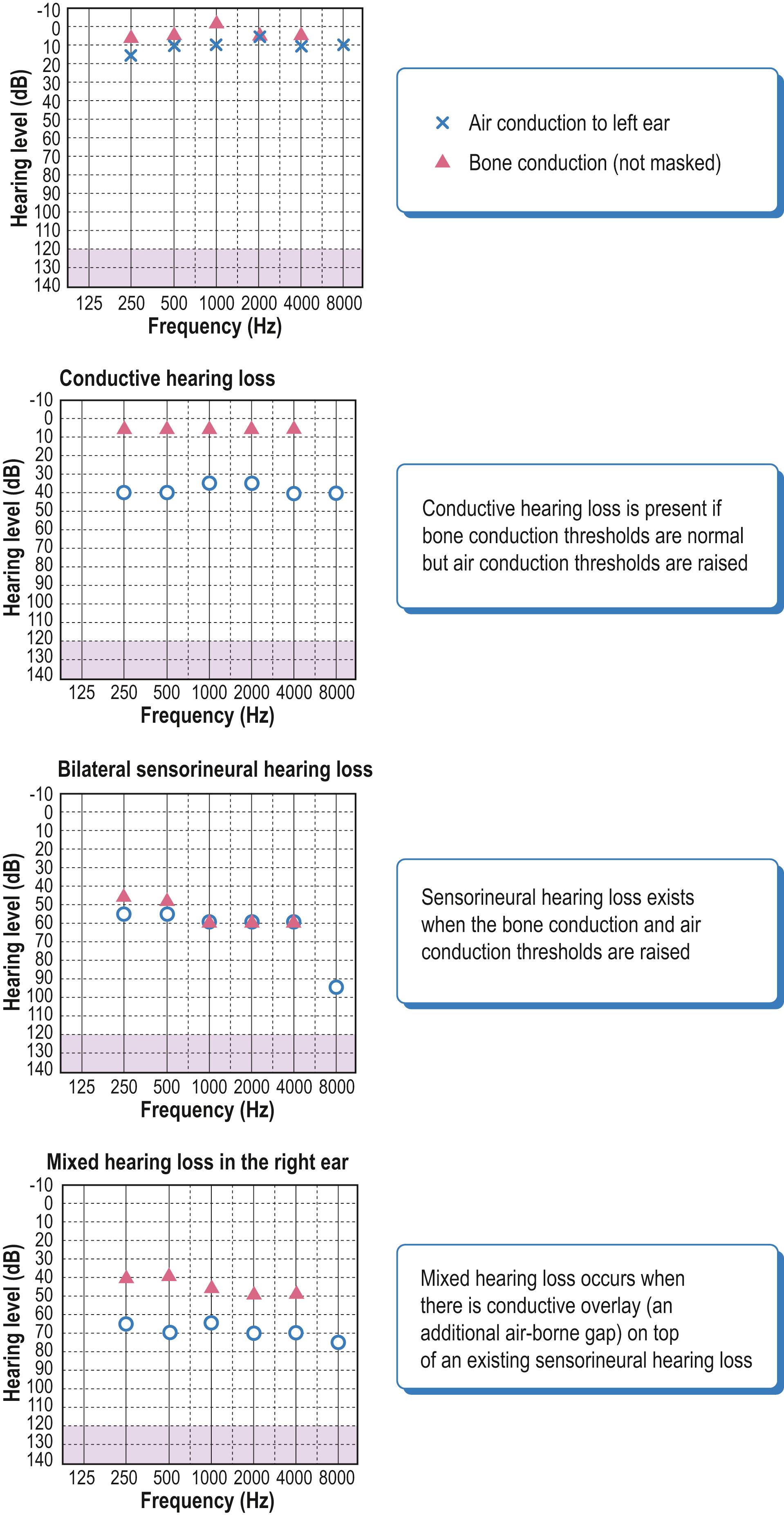Physical Address
304 North Cardinal St.
Dorchester Center, MA 02124
After reading this chapter you should be able to assess, diagnose and manage
hearing impairment
conditions affecting the ears, nose and throat including epistaxis
Paediatric hearing impairment impacts negatively on the speech, language, social, emotional and educational development of a child and should be considered as a cause in any child with speech, learning or behavioural difficulties. Prevention, timely diagnosis and early intervention of hearing loss can prevent further disability in development of linguistic, academic and social skills.
mild 26 to 40
moderate 41 to 70
severe 71 to 90
profound more than 90
dBHL—decibel hearing loss
A number of hearing assessments are available for children and the choice of these are dictated by the developmental age of the child.
newborn hearing screening
automated otoacoustic emission (aAOE)
automated auditory brainstem response (aABR)
6–18 months
visual reinforcement audiometry (VRA)
2–5 years old
play audiometry
5 years–adults
pure tone audiometry (PTA)
Newborn hearing screening is a universal programme that aims to identify permanent moderate, severe and profound deafness and hearing impairment in newborn babies. The test can be done on babies up to the age of 3 months.
Early detection and early intervention of hearing problems will lessen the impact of deafness on the child, the child’s family and society. All well babies undergo an automated otoacoustic emission test (aOAE). If this is not “passed” after two attempts, then the baby has an automated auditory brainstem response test (aABR). Babies in the neonatal intensive care or at high risk and have both an aOAE and an aABR test.
Acoustic emissions are sounds that are produced by the outer hair cells of the inner ear in response to a noise stimulus and can be measured by placing a small probe in the ear canal. Since the sounds are only produced by normal outer hair cells, their detection correlates highly with normal hearing. The vast majority of hearing impairment is due to damage of these cells and the test therefore provides a sensitive and accurate means of screening for cochlear hearing impairment.
Auditory brainstem response is an electrophysiological response that measures the function of the auditory pathway from the external ear to the brainstem when sounds are presented to the ear. It can determine hearing thresholds allowing targeted treatment depending on the severity of the hearing thresholds.
The test provides a “visual reward” when a child responds correctly by turning their head to sound played from headphones or field speakers on either side of the child and hearing thresholds are determined at different frequencies and amplitudes.
This test requires the child to respond to a sound by performing a simple task such as putting a ball in a bucket. This is repeated across different frequencies and at different volumes to determine the hearing thresholds.
The child usually wears headphones and is asked to respond when they hear the sound by pressing a button. The volume and frequency of the sound is adjusted to determine the hearing thresholds.
The test assesses the status of the middle ear by measuring mobility of the eardrum. It is not a hearing test but an assessment of the compliance of the eardrum.
The aetiology of paediatric hearing loss can be classified as congenital or acquired. Congenital hearing loss is present at birth and is due to genetic, prenatal or perinatal factors.
The type of hearing loss depends on where in the auditory pathway the impairment occurs. There are three basic types of hearing loss ( Figure 18.1 ).

Conductive hearing loss occurs when there is impairment of the sound transmission through either the outer or middle ear or both. Formal testing demonstrates that the bone conduction thresholds are better than air conduction thresholds. Conductive hearing loss produces losses of up to 50–60 dBHL.
The causes include:
ear canal obstruction—atresia, wax, foreign body
perforation of tympanic membrane
otitis media with effusion
Down syndrome
cranio-facial anomalies—Pierre Robin syndrome, cleft palate
Sensorineural hearing loss is due to impairment within the inner ear or sensory organ (cochlea and associated structures) or the vestibulocochlear nerve (cranial nerve VIII). Formal testing demonstrates that both bone conduction and air conduction thresholds are poor. It can be more severe than conductive impairment and can also be progressive.
The causes include:
congenital SNHL
genetic—syndromic or nonsyndromic
infection—congenital infections
prematurity
hypoxic ischaemic encephalopathy
acquired SNHL
ototoxic drugs—aminoglycosides, furosemide
meningoencephalitis
head injury
neurodegenerative disorders
hyperbilirubinemia
The hearing loss in sensorineural impairment is usually profound and usually greater than 90 dBHL. The children need prompt referral to ENT services for a more detailed assessment and consideration of the need for a hearing device. Aminoglycosides classically induce a high-tone hearing loss with a ‘ski slope’ appearance on the audiogram.
Become a Clinical Tree membership for Full access and enjoy Unlimited articles
If you are a member. Log in here